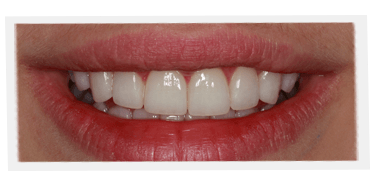
In Part 1 of Smile Design, we spoke about the Smile Line and Relative Dental Proportions when it comes to the design of a new smile. In Part 2, we touched on #3 Dominance of Maxillary Central Incisors and #4 Silhouettes. Now, we move on to #5 and #6, below. (Taken below from my book, A Guide to the Perfect Smile.)
#5 Progression of Maxillary incisal Embrasures
Incisal embrasures are the little spaces between the edges of your teeth that you can fit your mail into. There is a pattern of these embrasures that appeals to the eye. Ideally, the embrasure between the front two teeth is very small; the embrasure between the next two, the central and its lateral, is subsequently larger, about twice as big; and when you get to the third one, the embrasure between the lateral and the cuspid, its twice as big again. So in a pleasing smile, there’s a natural progression between the spaces of the teeth.
The pattern of embrasures is in fact an area where there is tremendous subjective opinion. In fact, various smile styles have various patterns for these embrasures. Often patients may like an even pattern of embrasures throughout the teeth, or no embrasures between the front four and perhaps a pronounced embrasure between the lateral and the cuspid, to create a “sporty” look. In fact, there are no fewer than 20 common incisal embrasure patterns, and this may be the single most important subjective principle that can greatly change the design of your smile.
#6 Progression of Contacts
Not only do the incisal edges of the teeth ideally have a certain convexity, but they must also “make contact” with each other in a pleasing way. By “contact” we mean the spot that floss binds between your teeth. The point at which the teeth make contact over the social six should mirror the convexity of the smile line. In other words, a very curvaceous smile line should have contacts that curve in the same manner. A relatively flat smile line would have contacts that line up relatively evenly.
Sometimes, if a tooth had moved or shifted over time or has been filled incorrectly, it will touch the tooth next to it at the wrong spot. The difference may be subtle, but it throws off the pattern of the teeth. As already discussed in this chapter, the eye is offended when it picks up conflicting patterns.
Ideally, each contact point steps up and follows the curve of the incisal edges. As incisal edges curve, the contacts curve the same way. Sometimes a dentist will achieve the correct edge on a patient’s tooth, but will get the contact on the wrong spot on the tooth. This makes the tooth look bulky or appear to be improperly placed.



